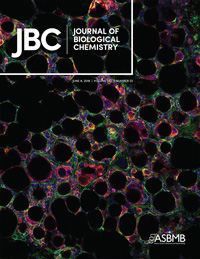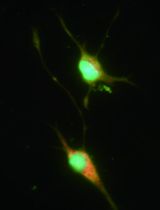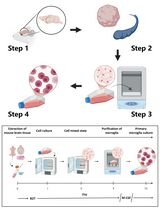- EN - English
- CN - 中文
Acute Isolation of Cells from Murine Sino-atrial Node
小鼠窦房结细胞的快速分离
发布: 2020年01月05日第10卷第1期 DOI: 10.21769/BioProtoc.3477 浏览次数: 5134
评审: Gal HaimovichAnonymous reviewer(s)
Abstract
The cardiac conduction system allows the synchronized propagation of electrical activity through heart muscle. This is initiated by the spontaneous activity of the specialized pacemaker cells of the sino-atrial node (SAN). The SAN region underlies automaticity in mammals and therefore has a crucial role in the pathogenesis of cardiac disorders such as arrhythmia. Isolation of SAN tissue and SAN cells is critical to advance our understanding of SAN structure and function in health and disease. Initially, isolation of SAN tissue and SAN cells was carried out in the rabbit owing to its larger size and similar electrical properties to human. This protocol was optimized by Mangoni and Nargeot (2001) for use in mice to take advantage of advancements in transgenic models. Here, we provide a step-by-step guide to dissecting the SAN tissue and isolating pacemaker cardiomyocytes from mouse hearts using an enzyme digestion approach.
Keywords: Conduction system (传导系统)Background
Cardiovascular diseases and abnormalities are a major cause of morbidity and mortality and are major burden on healthcare systems. Arrhythmias as result of changes in the structure, rate and rhythm of the cardiac conduction system underlie many cardiac disorders. In the past, a lack of availability of homogenous conduction system cell lines has proven to be a hindrance to investigators wishing to study the function of conduction system cells in health and disease. The emergence of transgenic animal models of cardiac abnormalities provides an even greater impetus to reliably isolate healthy conduction system cells. Intact nodes allow investigations into expression profiles of important signaling proteins and genes using immunohistochemistry and qPCR approaches. More detailed functional analysis is possible on isolated single nodal cells using patch-clamp for example. The SAN tissue and the cells it consists of were first isolated many decades ago (Noble and Tsien, 1968). However, the cell population isolated was generally a mixed population. SAN specific cells were first isolated from rabbit SAN by DiFranscesco et al. (1986) in the mid-1980s to allow study of ion channel expression. More recently, the protocol was adapted for isolation of SAN cells from mice by Mangoni and Nargeot (2001). This has allowed transgenic mouse models specific to the SAN to be studied in greater detail. We describe the procedure for isolating the SAN tissue and single SAN cells. The intact node can be used for investigation of gene and protein expression as well as for tissue histology, whilst acutely isolated cells can be interrogated in detail for their electrophysiological properties.
Materials and Reagents
- 15 ml Falcon tubes (Sarstedt, catalog number: 65.554.001)
- Petri Dish 100 x 21 mm (Thermo Fisher Scientific, NuncTM, catalog number: 172931)
- Sylgard 170-Silicone Elastomer (Dow Corning, Farnell, catalog number: 101693)
- 10 ml Glass vials with snap cap (VWR international, catalog number: 548-0555)
- 1 ml Syringe (Terumo, Scientific laboratory supplies, catalog number: SYR6200)
- 26 G needle (VWR International, catalog number: 613-3896)
- Insect pins (Fine Science Tools, catalog number: 260002-13)
- Pyrex disposable borosilicate culture tubes, Corning 99445-10 (Thermo Fisher Scientific, catalog number: 13023073)
- Multi-purpose parafilm M (Sigma-Aldrich, catalog number: P6543)
- Glass or plastic Beaker, 100 ml and 200 ml (Laboratory specific)
- Borosilicate Glass Pasteur Pipettes, autoclaved (Fisher Scientific, catalog number: 13-678-20C)
- 13 mm glass coverslips (VWR, catalog number: 631-0148)
- 12-well cell culture plates, Cellstar (Greiner Bio-One, catalog number: 665 180)
- Adult mice, 6-12 weeks, e.g., C57/Bl6 (The Jackson Laboratory, catalog number: 000664)
- Bovine Serum Albumin (Sigma-Aldrich, catalog number: A6003)
- Collagenase Type II (Worthington Biochemical Corp, catalog number: 4176)
- Elastase (Worthington Biochemical Corp, catalog number: 2292)
- Protease XIV (Sigma-Aldrich, catalog number: P5147)
- Laminin (Sigma-Aldrich, catalog number: L2020)
- Deionized, filtered water (dH2O) (Merck Millipore, Milli-Q)
- Sodium Chloride (NaCl) (Sigma-Aldrich, catalog number: S7653)
- Potassium Chloride (KCl) (Sigma-Aldrich, catalog number: P9333)
- Potassium Phosphate (KH2PO4) (Sigma-Aldrich, catalog number: P0662)
- L-Glutamic Acid (C5H9NO4) (Sigma-Aldrich, catalog number: 09581)
- Potassium Glutamate (C5H8KNO4·H2O) (Sigma-Aldrich, catalog number: G1501)
- Potassium Hydroxide pellets (KOH) (Sigma-Aldrich, catalog number: P6310)
- Sodium Hydroxide pellets (NaOH) (Thermo Fisher Scientific, catalog number: S/4920/53)
- HEPES-NaOH (Sigma-Aldrich, catalog number: H7006)
- HEPES-KOH (Sigma-Aldrich, catalog number: H0527)
- D-Glucose (Sigma-Aldrich, catalog number: G5767)
- Taurine (Sigma-Aldrich, catalog number: T8691)
- Calcium Chloride (CaCl2) 1 M solution (Fluka, catalog number: 21114)
- Magnesium Chloride (MgCl2) 1 M solution (Fluka, catalog number: 63026)
- DL-β-Hydroxybutyric acid sodium salt (Sigma-Aldrich, catalog number: H6501)
- Ketamine (Narketen-10) (Vetoquinox, procured via biological services unit)
- Xylazine (Rompun 2% w/v) (Bayer, procured via biological services unit)
- Heparin Sodium Salt (1,000 U/ml) (Wockhardt, procured via biological services unit)
- Tyrode solution (see Recipes)
- Tyrode-BSA solution (see Recipes)
- Low Ca2+/Mg2+ solution (see Recipes)
- Kraftbruhe (KB) solution (see Recipes)
- SAN storage solution (see Recipes)
- Enzyme digestion solution (see Recipes)
- Re-adaptation solution (see Recipes)
- Storage solution (mM) (see Recipes)
- Heparin/Ketamine/Xylazine Injection (see Recipes)
- Sylgard dissection dishes (see Recipes)
Equipment
- Scale and weighing (Laboratory specific)
- Dissecting scissors (World Precision Instruments, catalog number: 14192)
- Student Vannas scissors (World Precision Instruments, catalog number: 501777)
- Fine Vannas Scissors (World Precision Instruments, catalog number: 500086)
- Fine Vannas Scissors curved (World Precision Instruments, catalog number: 501232)
- 2x Dumont No.5 forceps (World Precision Instruments, catalog number: 500085)
- Zeiss Stereomicroscope Stemi2000 (Zeiss, catalog number: 455052)
- Grant Water Bath (Scientific Laboratory Supplies, catalog number: BAT3310)
- Stuart SSL4 See-Saw Rocker (Scientific Laboratory Supplies, catalog number: MIX2066)
- Cell Culture Incubator (Laboratory-specific)
- PIPETMAN Classic P10 (Gilson, catalog number: F144802)
- PIPETMAN Classic P100 (Gilson, catalog number: F144802)
- PIPETMAN Classic P200 (Gilson, catalog number: F144802)
- PIPETMAN Classic P1000 (Gilson, catalog number: F144802)
- Centrifuge 5810 R swing bucket for conical tubes (Eppendorf, model: 5810 R)
- Diamond cutting tool for glass (Amazon)
- Culture hood
Procedure
文章信息
版权信息
© 2020 The Authors; exclusive licensee Bio-protocol LLC.
如何引用
Readers should cite both the Bio-protocol article and the original research article where this protocol was used:
- Aziz, Q., Nobles, M. and Tinker, A. (2020). Acute Isolation of Cells from Murine Sino-atrial Node. Bio-protocol 10(1): e3477. DOI: 10.21769/BioProtoc.3477.
- Aziz, Q., Finlay, M., Montaigne, D., Ojake, L., Li, Y., Anderson, N., Ludwig, A. and Tinker, A. (2018). ATP-sensitive potassium channels in the sinoatrial node contribute to heart rate control and adaptation to hypoxia. J Biol Chem 293(23): 8912-8921.
分类
细胞生物学 > 细胞分离和培养 > 细胞分离
您对这篇实验方法有问题吗?
在此处发布您的问题,我们将邀请本文作者来回答。同时,我们会将您的问题发布到Bio-protocol Exchange,以便寻求社区成员的帮助。
提问指南
+ 问题描述
写下详细的问题描述,包括所有有助于他人回答您问题的信息(例如实验过程、条件和相关图像等)。
Share
Bluesky
X
Copy link












